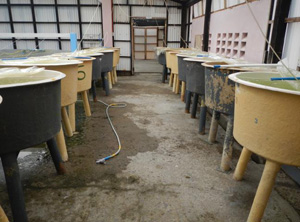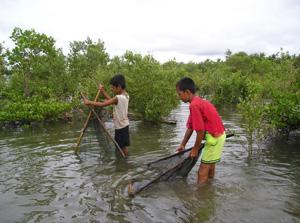 A project funded by the Department of Science and Technology (DOST) shows that the survival rate of mud crab from zoea to megalopae and zoea to crab instar has significantly improved through the use of formulated feeds and natural food.
A project funded by the Department of Science and Technology (DOST) shows that the survival rate of mud crab from zoea to megalopae and zoea to crab instar has significantly improved through the use of formulated feeds and natural food.
Titled, “Improvement of Larval Rearing Protocol,” the project is implemented by the Aquaculture Department, Southeast Asian Fisheries Development Center (SEAFDEC/AQD) and is led by Dr. Emilia T. Quinitio of the said agency.
The survival rate from zoea to megalopae has improved from 3.75% to 22.5%, while survival rate from zoea to crab instar has improved from 1.0-3.5% to 6%.
Currently, basic hatchery technology has been developed in the country, however, farms are still experiencing low survival rate at megalopae stage due to Molt Death Syndrome (MDS), a disease due to luminescent bacteria (Vibrio spp.). Antibiotics are still being used to treat Vibrio spp., however, incorrect use of antibiotics can cause incomplete molting, deformities, slow growth, and even death. Vibrio spp. is dominant in marine environments and can cause seafoodborne infections.
Furthermore, mud crab farmers are experiencing lack of crab seeds for farming from the wild due to over exploitation. The project addresses the need to manage resources and produce seed stocks in the hatchery for a sustainable mud crab industry. This would also reduce mud crab farmers’ dependence on sourcing seed stock from the wild.
To reduce the occurrence of MDS, the zoea is fed with formulated feeds and natural food. The use of natural food or rotifiers was reduced by as much as 50%. For natural food, minced fish or mussel can replace Artemia as feed during megalopae stage.
 In terms of antibiotic use, the project compared the performance of antibiotics, antimicrobial, nitrofuran, disinfectant, therapeutant, and probiotics in larval rearing. However, the project showed that the proper use of antibiotics, specifically furazolidone and oxytetracycline, is still the most effective way of preventing or treating diseases in mud crab.
In terms of antibiotic use, the project compared the performance of antibiotics, antimicrobial, nitrofuran, disinfectant, therapeutant, and probiotics in larval rearing. However, the project showed that the proper use of antibiotics, specifically furazolidone and oxytetracycline, is still the most effective way of preventing or treating diseases in mud crab.
To further equip farm owners and local government agencies, 22 collaborators and stakeholders were trained on the improved hatchery technology at SEAFDEC/AQD and in their respective sites.
Moreover, 13 mud crab hatcheries (9 privately owned, 2 with the local government unit (LGU), 2 with state universities and colleges (SUCs)) were established all over the country. These hatcheries have been producing crablets that will help sustain the mud crab industry. In Guindulman, Bohol, a prototype commercial-scale hatchery has been turned over to the LGU. This hatchery can produce about 40,000 crab instars per run.
The project is part of the National Mud Crab S&T Program, which is being monitored by the Philippine Council for Agriculture, Aquatic and Natural Resources Research and Development of DOST (DOST-PCAARRD).
